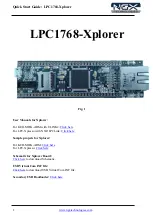
1.4. FPGA Fan
The FPGA fan is to be connected to the Eclypse Z7 via fan header J8 (labeled “FPGA”)
and is powered by VADJC, an adjustable rail controlled by the Platform MCU. The
FPGA fan's speed can be configured to Automatic (the default factory setting), High,
Medium, Low, or Off, by communicating with the PMCU through its I2C interface. This
configuration is preserved by the PMCU in an EEPROM when the Eclypse's power is
cycled. Additional information and configuration settings, including RPM and speed
controls, can be accessed through the PMCU's I2C interface.
1.5. Case Fan
In addition to the FPGA fan, the Eclypse Z7 can power a Case Fan, connected to the
board via fan header J14 (labeled “CASE”). This fan is powered by the 5V rail, and is
limited to 250 mA. A compatible fan is included in the
).
1.6. Platform MCU
As noted in previous sections, the Eclypse Z7 uses an Atmega328PB microcontroller
(IC10), referred to as the Platform MCU (PMCU), to implement the SmartVIO
requirements of the SYZYGY standard, as well as to monitor the Zynq die temperature,
and to control the Eclypse's fan.
When the Eclypse is turned on, the PMCU enumerates the pods attached to the
Eclypse's SYZYGY ports and retrieves their DNA, in order to correctly configure the
variable supplies.
After SYZYGY enumeration is complete, the PMCU configures itself as an I2C slave
device with a chip address of 0x60. Control of the I2C bus is then handed over to the
Zynq's I2C 1 peripheral (MIO[12:13]). The Digilent Eclypse Utility (decutil) is included in
the
Eclypse Z7 Base Petalinux Image
) which can be used to get status
information from and change some settings of the PMCU. For more information on the
PMCU's register space and communication protocol, see the PMCU specification (
). For more information on decutil, see the
).
The following tables describe the features of the Platform MCU supported by the
Eclypse Z7:
Table 1.6.1: Platform MCU Connectivity Map
PMCU Interface
Connection
TEMPERATURE A
Zynq Die Temperature















































